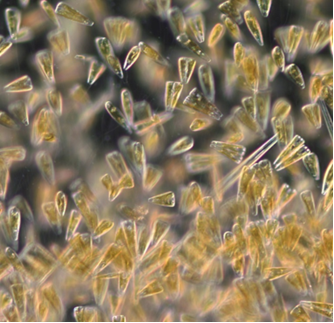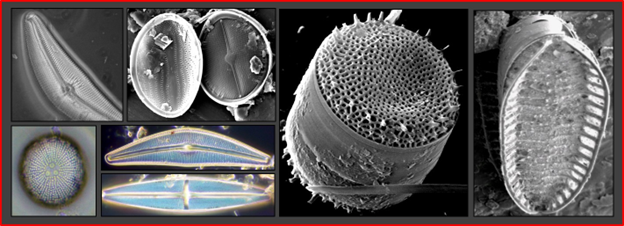Diatoms – Solving an Identity Issue

Published December 13, 2022
Diatoms are single-celled algae found in almost all aquatic habitats. They are very particular about the quality of water in which they live, which makes them incredible indicators of water quality and ecosystem health. Even though diatoms are collected in EPA’s National Aquatic Resource Surveys (NARS), they are not yet included as a biological indicator in the NARS assessments. The key barrier to their use has been the lack of consistency in the identification of species.
Along with other samples for the NARS assessments, diatom samples are shipped to labs across the country and processed by multiple analysts. Because of issues with analyst practices—like the use of different taxonomic references among labs, and/or geographically relevant taxonomic guides (or floras)—analysts working on the same project (or with the same data) may assign different names to the same species. This has led to inconsistencies in taxonomic identification that has compromised the quality and confidence in diatom datasets and limited the use of diatoms in NARS, as well as many state bioassessment programs.
Recent efforts to resolve the taxonomic issues bear good news for the use of diatom data across programs. Novel EPA research using three different approaches: taxonomic harmonization of species-level data; genus-level data and trait information; and DNA metabarcoding has the potential to unlock the utility of diatoms as an important indicator in NARS assessments.

With the first approach - taxonomic harmonization – researchers determine the names of diatoms that were consistently difficult to identify which reduces the taxonomic inconsistencies and improves the confidence in data quality. Once named, they are grouped with other diatoms in the dataset with similar morphology. Using statistical tools that aid taxonomic harmonization, researchers can minimize the effect of taxonomic inconsistency across analysts to better detect and clarify diatom relationships with different environmental stressors. These efforts to resolve taxonomy provide greater confidence in using diatom data and improve the application of these data in the development of bioassessment tools and water quality indicators.
EPA also developed an effective genus-level diatom approach that avoids the taxonomic inconsistency in species-level identifications in the National Rivers and Streams Assessment (NRSA) diatom datasets. This approach used trait-based characteristics of individual genera to develop diatom multimetric indices (MMIs) using NRSA data. The genus-level diatom MMIs did an excellent job distinguishing from least-disturbed and most-disturbed rivers and streams, showing they have potential value in NRSA assessments and in quantifying the effectiveness of the nation’s pursuit to maintain and restore the nation’s biotic integrity. These MMIs are designed to assess river and stream ecological condition in three large ecoregions spanning the conterminous U.S., and the results further highlight how diatoms could provide important information in future NRSA surveys.

Finally, EPA also uses a technique, DNA metabarcoding, to quantify diatom responses to nutrients in streams. Instead of using a microscope to identify and count diatom species, this technique analyzes and quantifies diversity in samples by identifying and counting the number of unique DNA sequences of a specific diatom gene. DNA metabarcoding data are then used to identify how diatoms respond to environmental conditions, such as nutrient concentrations. These diatom-environment relationships can then be used to inform stream protection efforts and their respective management goals. As part of ongoing research, EPA scientists are using DNA metabarcoding to understand how diatom-environment relationships differ among regions of the conterminous U.S.
These three approaches: taxonomic harmonization of species-level data; development of MMIs using trait information and/or genus-level data; and DNA metabarcoding allow EPA to use cutting-edge research to address existing long-term challenges with NARS diatom data. Now that EPA is making strides in the diatom taxonomy, these algae could be a valuable asset to determine the biological condition of our nation’s waters.
In addition, EPA could use diatoms to help address other waterbody stressors, like excess nutrients, that cause nutrient pollution, a widespread problem for freshwater ecosystems throughout the United States and around the world. Diatoms’ relationships with nutrient concentrations can help inform the assessment, conservation, and management of stream ecosystems and watersheds. This information may contribute to how EPA develops biological indicators of nutrient pollution. In the last NRSA, 46% of our nation’s rivers and streams were found to be in poor biological condition. The NRSA suggests that reducing nutrient pollution and improving habitat will improve the biological health of rivers and streams. By using diatoms, EPA is one step closer to solving this issue.
Read more about these aquatic gems:
- Genus-level, trait-based multimetric diatom indices for assessing the ecological condition of rivers and streams across the conterminous United States
- DNA metabarcoding effectively quantifies diatom responses to nutrients in streams (2020)
- Resources and Practices to Improve Diatom Data Quality (2021)
- Taxonomic harmonization may reveal a stronger association between diatom assemblages and total phosphorus in large datasets (2019)
- Harmonization of sediment diatoms from hundreds of lakes in the northeastern United States (2022)
